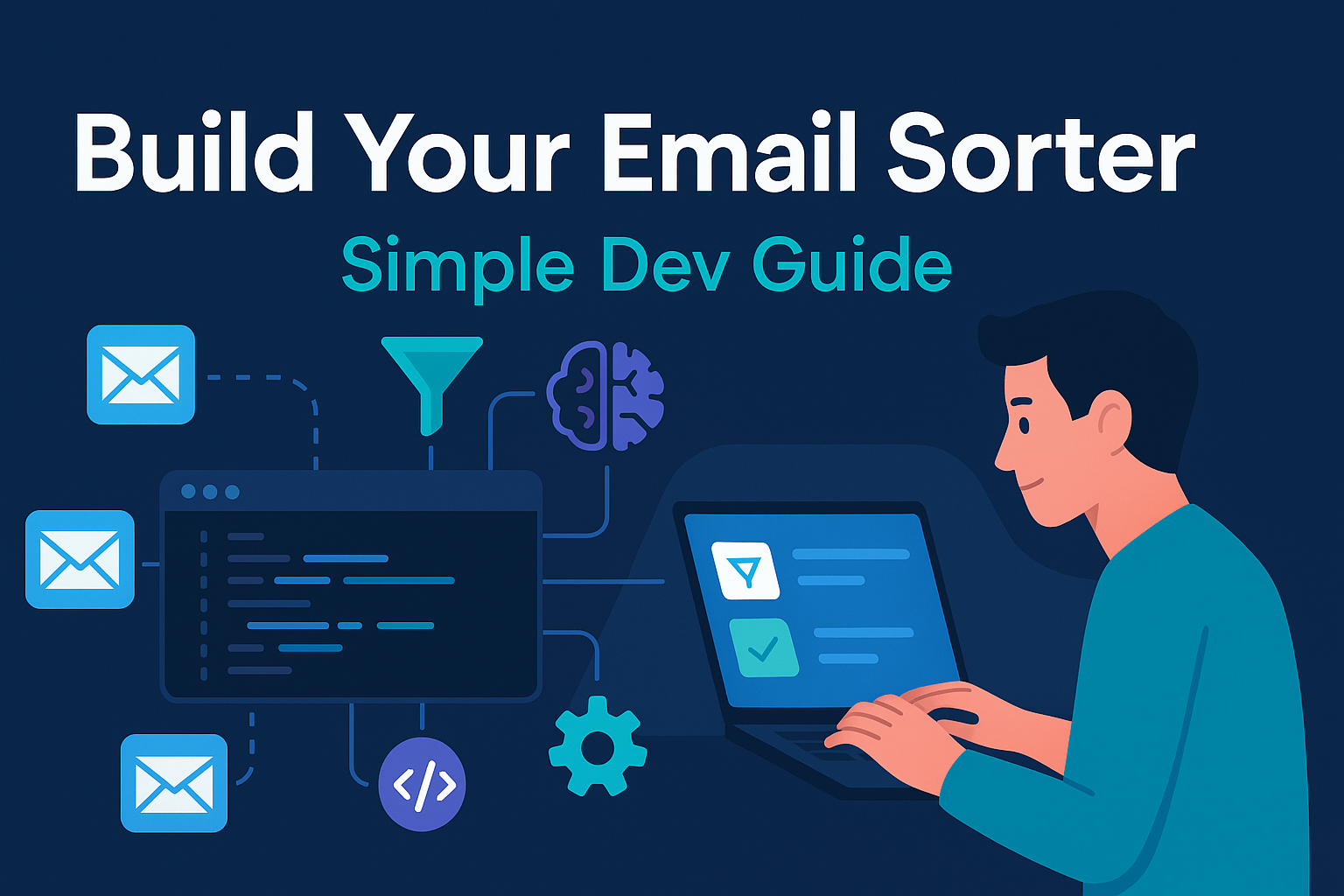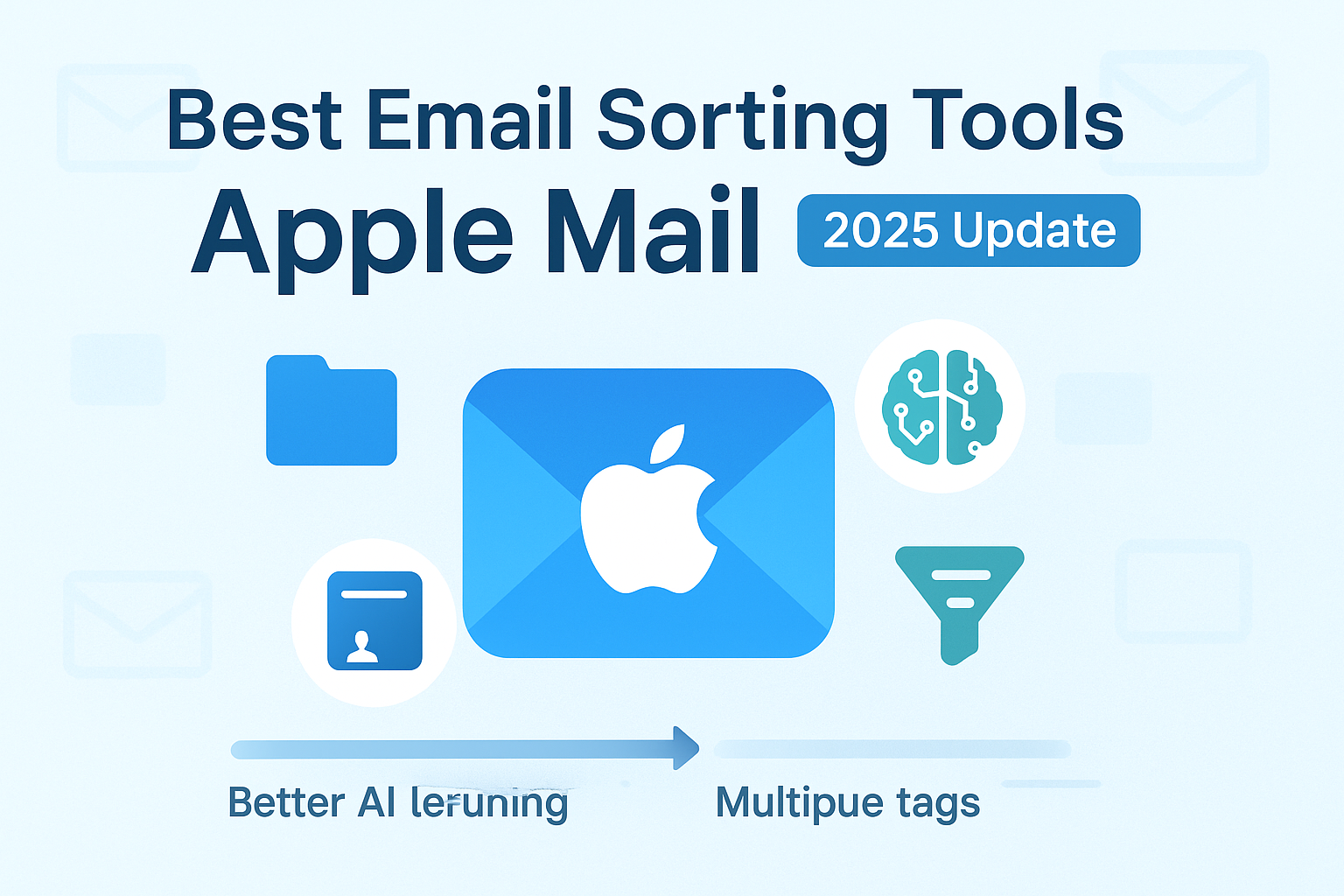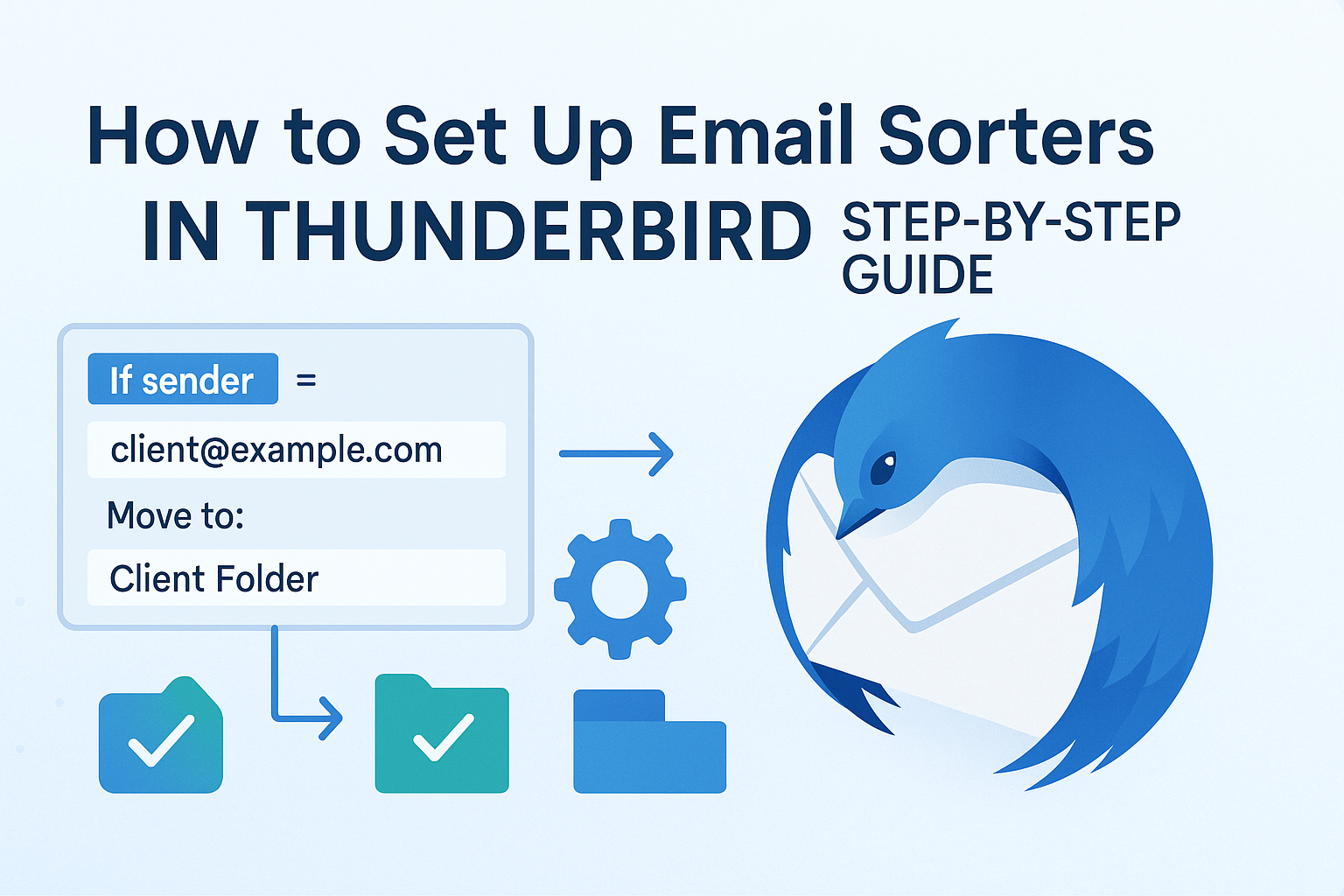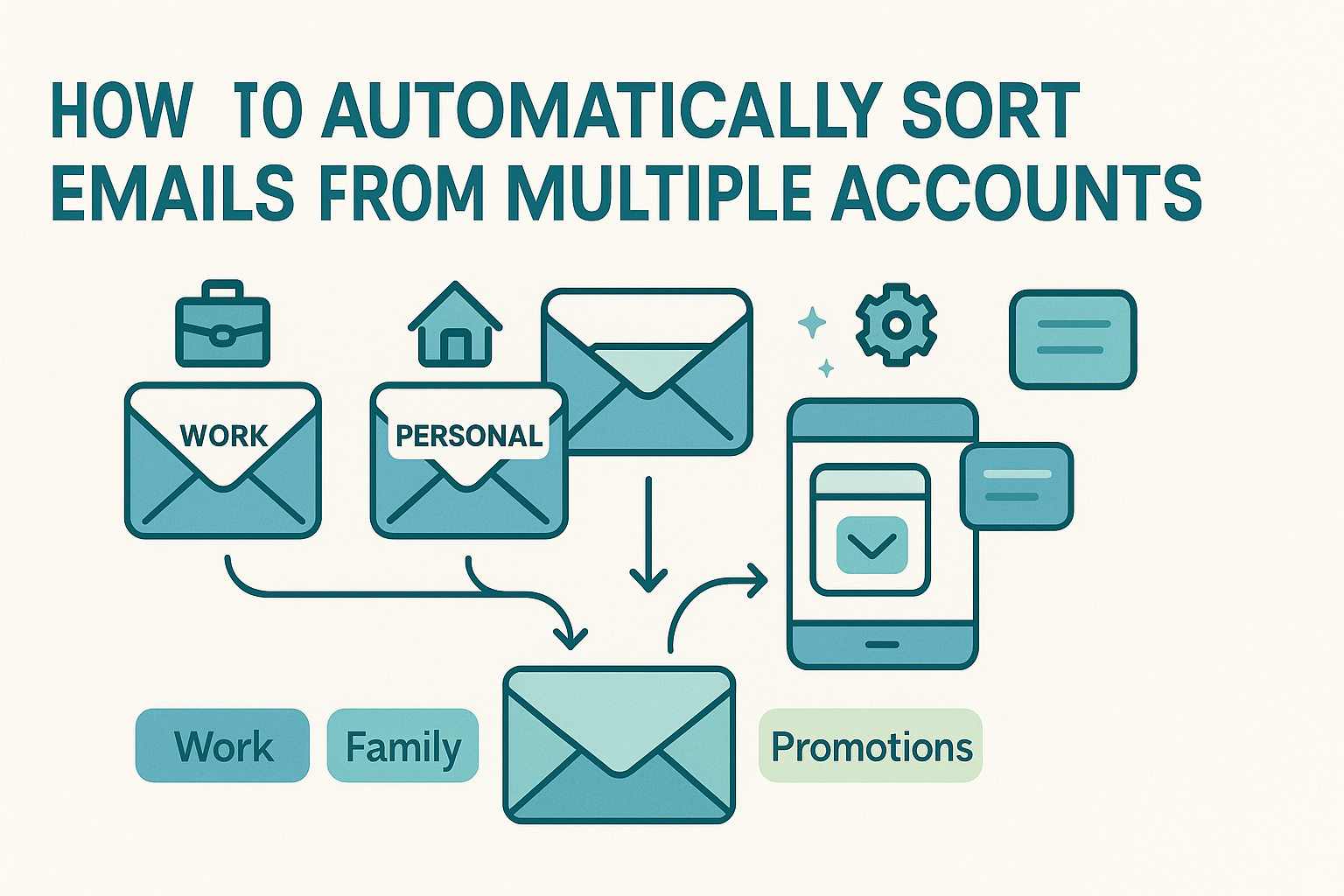Looking to build an email sorter that fits your exact workflow? While popular tools offer basic filters and automation, they often come with limits, restricted rules, cloud lock-in, or minimal integration flexibility. For developers, a custom email sorting system offers total control: smarter filtering, better routing, and full ownership of how email flows through your stack.
Whether you’re sorting high-volume inboxes, directing leads into your CRM, or organizing system alerts across teams, building your own email filtering logic lets you automate everything, on your terms. From parsing raw emails to creating custom rules for tagging, prioritizing, and integrating with internal tools, a tailored solution gives you power no off-the-shelf tool can match.
If you’re ready to take control of your inbox infrastructure, now’s the time to build your own email sorter, flexible, scalable, and designed around your codebase.
Foundations: How Email Sorting Works
Before you begin writing code, it’s important to understand how email sorting works conceptually. An email sorter is, at its core, a program that receives messages, applies a set of filters or logic, and performs actions like tagging, labeling, moving, or forwarding those messages. These actions might seem simple, but under the hood, they rely on a sequence of components working in sync.
Most email sorters are built on four foundational parts:
- Access Layer: This is how your sorter connects to an inbox. It could be through IMAP, SMTP, or a service-specific API like Gmail or Outlook. You’ll use these interfaces to read messages, mark them as read, or move them between folders.
- Parser: Once you’ve pulled a message, you’ll need to break it down. This includes extracting the subject line, body text, sender address, attachments, and sometimes even headers. Parsing ensures your sorter can understand what the message contains.
- Logic Engine: This is the brain of your sorter. Here you define how messages are evaluated. For example, you might say “if the subject contains ‘invoice’ and sender is accounts@vendor.com, move to the Finance folder.” These rules can be hard-coded or powered by machine learning to adapt dynamically.
- Action Layer: After processing, the sorter executes actions based on logic results. That might mean applying a label, moving the email, sending a webhook, or storing metadata in a database.
To get comfortable with this structure, it’s worth reviewing email sorting glossary terms, which define the most common technical elements involved in the sorting process. Understanding terms like IMAP, MIME, message ID, threading, and filters will help as we begin connecting your sorter to live email accounts.
Next, we’ll dive into how to access your inbox programmatically, and how to retrieve the messages your sorter will eventually process.
Accessing Your Inbox
The first technical step in building your email sorter is enabling it to read emails from your inbox. This usually involves using IMAP (Internet Message Access Protocol) or, for sending emails, SMTP. Most modern email services (Gmail, Outlook, Yahoo) support IMAP, and many also expose RESTful APIs for more granular control. Gmail, for example, offers OAuth-secured access via the Google Cloud email APIs, allowing developers to work within scopes and permissions instead of storing passwords.
For IMAP access using Python, here’s a quick connection example:
import imaplib
import email
# Connect to Gmail IMAP
mail = imaplib.IMAP4_SSL(‘imap.gmail.com’)
mail.login(‘your_email@gmail.com’, ‘your_password’) # Use OAuth in production
mail.select(‘inbox’)
# Search and fetch emails
status, data = mail.search(None, ‘ALL’)
email_ids = data[0].split()
for eid in email_ids:
_, msg_data = mail.fetch(eid, ‘(RFC822)’)
msg = email.message_from_bytes(msg_data[0][1])
print(“From:”, msg[‘From’], “Subject:”, msg[‘Subject’])
This is the foundation: your script connects to the inbox, retrieves emails, and reads metadata. Once you have access, you can filter for unread messages, recent messages, or those containing specific headers. If you’re using an API instead of IMAP, authentication typically involves setting up an OAuth2 workflow, retrieving a token, and calling the endpoint using HTTP.
More advanced tools let you control more than just fetching emails, they allow batching, pagination, folder management, and even webhook notifications when new mail arrives. These APIs, such as those found in the email API development guide, are especially useful if you’re planning a real-time sorter or integrating with external systems.
Applying Rules: Basic Logic Layer
Once your sorter has access to the email content, the next step is deciding what to do with it. This is where logic comes into play. Rule-based filtering works by applying conditional statements to each message. You extract fields like the sender address, subject, or keywords in the body, and then trigger actions if conditions are met.
Here’s a simplified pseudocode version of a rule system:
def apply_rules(email):
if ‘invoice’ in email.subject.lower() and ‘accounts@vendor.com’ in email.sender:
move_to_folder(email, ‘Finance’)
elif ‘meeting’ in email.subject.lower():
tag_email(email, ‘Meetings’)
else:
archive_email(email)
This example uses simple if-statements to identify and act on emails. But as your needs grow, you may want to build a more scalable rules engine—one where rules are stored in JSON and evaluated dynamically:
{
“rules”: [
{
“condition”: {
“field”: “subject”,
“contains”: “invoice”
},
“action”: {
“type”: “move”,
“folder”: “Finance”
}
}
]
}
This makes your sorter more extensible and user-configurable. You can store these JSON rules in a database, edit them via a web UI, and have your backend script interpret them at runtime.
If you want to make this logic smarter and adaptive, look into articles like smart email sorting rules, which explain how modern tools are built with rule layers that support AND/OR conditions, nested criteria, and exception handling (e.g., don’t sort if flagged as VIP).
At this stage, you’ve connected to your inbox, retrieved messages, and implemented a rule engine. Next, we’ll explore how to use open-source libraries to streamline parsing and how to expand into machine learning.
Using Open‑Source Libraries
If you’re not looking to build every component of your sorter from scratch, open-source libraries can dramatically reduce the complexity. These tools handle common tasks like parsing MIME content, decoding attachments, or handling IMAP/SMTP connectivity in a reliable, well-tested way. For example, in Python, mail-parser is a great library for breaking down email content without requiring deep MIME decoding knowledge. You simply pass it a raw email message, and it extracts headers, bodies, and metadata in a developer-friendly structure.
Another useful option is imapclient, which simplifies IMAP usage compared to the lower-level imaplib. It provides a cleaner API for searching messages, managing folders, and processing inbox events.
On the JavaScript side, node-imap is widely used for connecting to email accounts and listening for new messages in real time. It pairs well with mailparser, which extracts content fields from the raw email payload. These tools allow you to build an email processing loop that operates continuously or on a scheduled basis using cron jobs or background workers.
If you’re considering self-hosted, fully functional platforms to fork or contribute to, check out several open-source email sorters available on GitHub. These often include sample architectures using Flask, Django, or Node.js, and sometimes even contain pre-configured rule engines. Starting from these templates can help you launch faster, especially if you’re planning to turn your sorter into a deployable SaaS or team tool.
Using these libraries reduces friction and lets you focus more on customizing the logic, rather than reinventing how to fetch or parse email messages from scratch.
Adding Machine Learning
After you’ve built a rule-based system, you might want your sorter to handle fuzzier cases—emails that don’t match explicit rules but still follow patterns. This is where machine learning (ML) steps in. ML-powered sorters can classify emails based on prior examples, even if you didn’t define hard logic. For instance, they can label an email as a “lead” or “support request” even if the keywords vary.
A simple starting point is using keyword classification with TF-IDF and Naive Bayes or logistic regression. Here’s how you can build a basic classifier with scikit-learn:
from sklearn.feature_extraction.text import TfidfVectorizer
from sklearn.linear_model import LogisticRegression
# Sample training data
emails = [“Request for pricing”, “Server down issue”, “Schedule a demo”, “Invoice for Q1”]
labels = [“Sales”, “Support”, “Sales”, “Finance”]
vectorizer = TfidfVectorizer()
X = vectorizer.fit_transform(emails)
model = LogisticRegression()
model.fit(X, labels)
# Predict new email
new_email = [“How do I reset my password?”]
X_new = vectorizer.transform(new_email)
print(model.predict(X_new))
This can be expanded with a labeled dataset, where you teach your model the difference between invoice emails, customer service requests, and internal updates. You can then combine this model with your logic engine: if no rule applies, fall back to the model’s suggestion.
More advanced use cases involve using transformers or fine-tuned LLMs to read context within the message body. If you’re ready to go deeper, the guide on how to train an AI email sorter from scratch walks through dataset creation, model architecture, evaluation, and even integration tips for Python backends.
Using ML allows your sorter to evolve over time—getting smarter as more emails are processed—and builds resilience against edge cases that static rules often miss. Just be sure to keep transparency in mind: log predictions, track accuracy, and allow manual corrections to keep the model honest and useful.
Integrating Email‑Automation APIs
Once your email sorter is classifying and processing messages reliably, the next step is to connect it to other systems. Email doesn’t exist in a vacuum—it often needs to trigger external actions, whether that’s notifying a team, updating a dashboard, or forwarding critical messages to another app. This is where email-automation APIs come into play.
Many platforms like Postmark, SendGrid, or Mailgun offer APIs that not only send emails but also allow real-time event tracking, tagging, and webhook integration. If your sorter runs on a schedule or responds to incoming emails in real-time, you can use these APIs to initiate actions like sending a confirmation, logging to a support system, or even triggering a Slack alert.
For example, Postmark offers a RESTful interface to programmatically route messages, which makes it ideal for cases where your sorter needs to respond to categorized emails. When building your own system, referencing the Postmark API sorter helps you understand how modern transactional APIs work—especially when you’re routing parsed email content into ticketing systems or CRMs.
Let’s look at a sample payload that might be sent from your sorter to an automation service:
json
CopyEdit
{
“type”: “lead_notification”,
“sender”: “jane@startup.com”,
“subject”: “Partnership inquiry”,
“priority”: “high”,
“tags”: [“lead”, “business”],
“timestamp”: “2025-06-23T13:45:00Z”
}
APIs like Zapier or Make.com can take this payload and instantly send it to Salesforce, add a line to a spreadsheet, or post it to a shared Slack channel. This structure allows your sorter to become an intelligent part of your workflow automation stack—not just a passive filter.
If you’re working on backend integrations, the article on email sorting automation APIs includes the best libraries and services to integrate with, covering auth, rate limiting, and batching considerations. That guide can also help you figure out whether you need RESTful APIs or event-based workflows.
Hooking Into Lead Workflows
If you’re in a business setting—particularly sales or customer support—you’ll likely want your email sorter to do more than just tag emails. You want it to plug directly into your lead routing or ticketing system. This means turning each processed email into a structured data object and sending it to the right team, user, or software.
Imagine this scenario: A potential customer emails your support line, asking about enterprise pricing. Instead of that email sitting in a shared inbox, your sorter detects it, applies a “Sales” label, checks if the sender is new, and then sends it directly to your CRM as a new lead. If this is a repeat sender, it updates their contact record or appends a note. That’s real efficiency—and it saves your sales team hours per week.
To make this possible, your sorter should support webhook-based integrations or direct API calls into tools like HubSpot, Salesforce, or Zoho CRM. You might use custom headers or tags to drive conditional logic. This could look something like:
def handle_lead(email):
data = {
“first_name”: extract_name(email.sender),
“email”: email.sender,
“source”: “inbound-email”,
“notes”: email.subject + ” – ” + email.body[:100]
}
post_to_crm(data)
This workflow depends on how your CRM handles API authentication, lead deduplication, and record updates. But the advantage of building it yourself is that you can design logic that mirrors your exact business rules.
To see what smart routing looks like in action, check out this breakdown on AI lead routing tools, which demonstrates how modern sorters and lead handlers use scoring, time zones, and past engagement to match each message with the right rep. Your custom sorter can tap into similar ideas by using metadata like sender domain, message sentiment, or keyword density.
By integrating lead detection and routing into your sorter, you’re effectively automating the top of your sales funnel—saving money, improving response times, and ensuring no warm lead gets lost in the clutter.
Deploying Your Sorter
Once your parsing, logic, and integrations are in place, it’s time to deploy your sorter. Many DIY developers run code locally during prototyping, but production-grade sorting requires reliability and uptime. A few deployment options include:
First, using a cron job on a dedicated server or virtual machine ensures the sorter fetches new messages and processes them at regular intervals (e.g., every 5 minutes). This is straightforward and gives you full control but requires management of uptime, updates, and backups.
If you’d rather have a serverless setup, tools like AWS Lambda, Google Cloud Functions, or Azure Functions allow you to process email events without managing servers. You can trigger processing via Pub/Sub or webhook listeners—for example, Gmail’s push notifications invoking your function when new messages arrive.
Containers are another option: package your sorter as a Docker image, deploy it to Kubernetes or a managed container service, and use cron or event triggers to start its logic. This balances control and scalability.
Whichever method you choose, you’ll want to include environment variables for sensitive credentials, separate staging from production credentials, and deploy code through a CI/CD pipeline to ensure easy updates and rollbacks.
Monitoring and Logging
Automation is useful only when it works reliably. To make your sorter trustworthy, implement robust monitoring and logging. Track each email processed, the logic applied, and the action taken:
logger.info(f”Email from {email.sender} processed by rule {rule_name}, moved to {folder}”)
Capture failures—if a rule application or webhook fails—to enable reporting or alerting. In serverless environments, link logs to a monitoring service and set up alerts for high failure rates or repeated errors.
Dashboards showing the number of emails sorted, actions applied, and mailbox growth can help maintain visibility. Logs also support debugging and provide accountability, helpful for understanding why an email wasn’t sorted or routed. Including simple dashboards or CSV exports can also help you analyze usage patterns and refine rules over time.
Scaling and Performance
As your inbox and rule set grow, performance issues can surface. Batching operations help reduce API calls—for example, fetching 50 emails at once and applying tag actions in bulk.
Implement lazy loading of older emails and ensure the sorter marks messages as seen or archived after processing to avoid re-processing. For large mailboxes, implement pagination and throttling so the sorter respects rate limits and API quotas.
For multi-user or team use, running multiple workers in parallel to process different folders or mailboxes can keep performance snappy. Caching sender metadata can also reduce lookup delays and improve system speed over time.
Security Best Practices
Sorting email means working with sensitive data, so security is critical:
Store credentials securely—use environment variables or secrets managers rather than hardcoding.
Use OAuth or app-specific tokens where possible to limit permissions.
Encrypt communications (IMAP SSL/TLS) and stored data at rest.
Adhere to the principle of least privilege: don’t request more folder access than necessary.
Make sure webhook endpoints validate payload signatures to prevent forgery.
Rotate tokens regularly, and maintain audit logs to track system access and rule changes.
DIY vs Off‑the‑Shelf Sorters
Building your own sorter delivers unmatched flexibility and full control. You can implement complex routing, integrate with niche systems, and bypass vendor lock-in. However, it demands continuous maintenance, security oversight, and monitoring investment.
On the flip side, off-the-shelf solutions, many of which appear in comprehensive comparisons like top email sorting software, provide user-friendly rules, prebuilt integrations, and enterprise plans. They also handle uptime, security, and support. But they might lack custom routing logic, transparency, or deployment control.
A hybrid approach is also viable: use a commercial sorter for general needs and build a small custom service to handle niche logic, like routing specific lead types or connecting to internal databases.
Conclusion
Whether you’re a solo developer, team lead, or part of a small IT team, building your own email sorter offers unmatched flexibility and privacy. You’ll gain a platform that integrates with your unique tools, makes routing accurate, and handles edge cases without compromise.
Follow this guide to build a sorter that reads, evaluates, and routes email automatically—then iterate by adding AI, monitoring, and CRM integrations. With a robust foundation, your sorter becomes an essential tool for communication management tailored to your world.
FAQs
Q1: Do I need machine learning to build a sorter?
No. Rule-based logic alone can solve many real-world use cases. ML is optional and useful for fuzzy or changing criteria.
Q2: Can I use Gmail for IMAP access?
Yes, Gmail supports IMAP, SMTP, and RESTful API access. Use OAuth and the Google Cloud email APIs for secure integration.
Q3: How often should the sorter run?
It depends on your workflow: every minute for near‑real‑time handling, or every 5–15 minutes for most use cases. Balance responsiveness with rate limits.
Q4: Is it safe to store credentials in code?
No. Always use environment variables or a secrets manager. Never commit credentials to source control.
Q5: How hard is CRM integration?
With most CRMs offering REST APIs or webhook support, basic integration is relatively simple. Handling duplicates and mapping correctly requires some planning, but the logic is straightforward.




